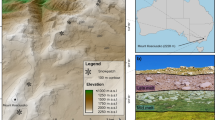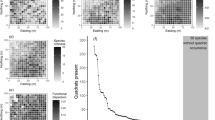Abstract
Environmental filters act to limit the local community assemblage from the regional species pool by restricting the viable trait states that can occur there. In alpine snowpatches, the timing of snowmelt is a strong environmental filter. In coming decades, the strength of this filter is likely to relax with global climate change. We used three continuous plant functional traits (leaf area, plant height, seed mass) and their divergence (using the FDvar index) to document current patterns of community assembly and predict plant community responses to future environmental filters in alpine snowpatch vegetation. The community trait-weighted mean for leaf area and height, but not seed mass, was significantly higher in early snowmelt zones relative to mid and late melting zones across all snowpatches. Mean FDvar for height (but not leaf area or seed mass), by contrast, was substantially lower in early snowmelt zones, indicating that species growing in early melt zones are consistently taller than those growing in other zones. These results suggest that if climate change leads to earlier snowmelt and hence, a longer growing season, taller (more competitive) species with larger leaf areas (more productive) may replace short species in snowpatches as these plant communities re-assemble in response to changing environmental filters.



Similar content being viewed by others
References
Atkin OK, Collier DE (1992) Relationship between soil nitrogen and floristic variation in late snow areas of the Koscuisko alpine region. Aust J Bot 40:139–149
Bannister P, Maegli T, Dickinson KJM, Halloy SRP, Knight A, Lord JM, Mark AF, Spenser KL (2005) Will loss of snow cover during climatic warming expose New Zealand alpine plants to increased frost damage? Oecologia 144:245–256
Baptist F, Choler P (2008) A simulation of the importance of length of growing season and canopy functional properties on the seasonal gross primary production of temperate alpine meadows. Ann Bot 101:549–559
Baptist F, Flahaut C, Streb P, Choler P (2010) No increase in alpine snowbed productivity in response to experimental lengthening of the growing season. Plant Biol. doi:10.1111/j.1438-8677.2009.00286.x
Björk RG, Molau U (2007) Ecology of alpine snowbeds and the impact of global change. Arct Antarct Alp Res 39:34–43
Canaday BB, Fonda RW (1974) The influence of subalpine snowbanks on vegetation pattern, production and phenology. Bull Torrey Bot Club 101:340–350
Choler P (2005) Consistent shifts in alpine plant traits along a mesotopographical gradient. Arct Antarct Alp Res 37:444–453
Cornelissen JHC, Lavorel S, Garnier E, Diaz S, Buchman N, Gurvich DE, Reich PB, ter Steege H, Morgan HD, van der Heijden MGA, Pausas JG, Poorter H (2003) A handbook of protocols for standardised and easy measurement of plant functional traits worldwide. Aust J Bot 51:335–380
Cornwell WK, Ackerly DD (2009) Community assembly and shifts in the distribution of functional trait values across an environmental gradient in coastal California. Ecol Monogr 79:109–126
Costin AB (1954) A study of the ecosystems of the Monaro region of New South Wales with special reference to soil erosion. Soil Conservation Service of New South Wales, Sydney
Costin AB, Gray M, Totterdell CJ, Wimbush DJ (2000) Kosciuszko alpine flora. CSIRO, Melbourne
Cumming G, Finch S (2005) Inference by eye—confidence intervals and how to read pictures of data. Am Psychol 60:170–180
Díaz S, Cabido M (2001) Vive la difference: plant functional diversity matters to ecosystem processes. Trends Ecol Evol 16:646–655
Díaz S, Marcelo C, Fernando C (1998) Plant functional traits and environmental filters at a regional scale. J Veg Sci 9:113–122
Edmonds T, Lunt ID, Roshier DA, Louis J (2006) Annual variation in the distribution of summer snowdrifts in the Kosciuszko alpine area, Australia, and its effect on the composition and structure of alpine vegetation. Austral Ecol 31:837–848
Edwards AC, Scalenghe R, Freppaz M (2007) Changes in the seasonal snow cover of alpine regions and its effect on soil processes: a review. Quat Int 162–163:172–181
Ernst R, Linsenmair KE, Rodel M-O (2006) Diversity erosion beyond the species level: dramatic loss of functional diversity after selective logging in two tropical amphibian communities. Biol Conserv 133:143–155
Flynn DB, Gogol-Prokurat M, Nogeire T, Molinari N, Trautman Richers B, Lin BB, Simpson N, Mayfield MM, Declerck F (2009) Loss of functional diversity under land use intensification across multiple taxa. Ecol Lett 12:22–33
Galen C, Stanton ML (1995) Responses of snowbed plant species to changes in growing season length. Ecology 76:1546–1557
Good RB (1992) Kosciusko heritage. The National Parks and Wildlife Service of New South Wales, Sydney
Green K, Pickering CM (2009a) The decline of snowpatches in the Snowy Mountains of Australia: importance of climate warming, variable snow, and wind. Arct Antarct Alp Res 41:212–218
Green K, Pickering CM (2009b) Vegetation, microclimate and soils associated with the latest lying snowpatches in Australia. Plant Ecol Divers 2:289–300
Grime JP (1973) Competitive exclusion in herbaceous vegetation. Nature 242:344–347
Grime JP (2001) Plant strategies, vegetation processes and ecosystem properties, 2nd edn. Wiley, Chichester
Hennessey K, Whetton P, Smith I, Bathols J, Hutchinson M, Sharples J (2003) The impact of climate change on snow conditions in mainland Australia. CSIRO Atmospheric Research, Aspendale
Holler P, Fromm R, Leitinger G (2009) Snow forces on forest plants due to creep and glide. For Ecol Manag 257:546–552
Inouye DW (2008) Effects of climate change on phenology, frost damage and floral abundance of montane wildflowers. Ecology 89:353–362
Inouye DW, McGuire AD (1991) Effects of snowpack on timing and abundance of flowering in Delphinium nelsonii (Ranunculaceae): implications of climate change. Am J Bot 78:997–1001
Jarrad FC, Wahren C-H, Williams RJ, Burgman MA (2009) Subalpine plants show short-term positive growth responses to experimental warming and fire. Aust J Bot 57:465–473
Keddy PA (1992) Assembly and response rules: two goals for predictive community ecology. Science 3:157–164
Kudo G (1991) Effects of snow-free period on the phenology of alpine plants inhabiting snowpatches. Arct Antarct Alp Res 23:436–443
Lepš J, de Bello F (2008) Macro for calculation of functional diversity. University of South Bohemia, Czech Republic. http://botanika.bf.jcu.cz/suspa.FunctDiv.php. Accessed 14 Jul 2009
Lepš J, de Bello F, Lavorel S, Berman S (2006) Quantifying and interpreting functional diversity of natural communities: practical considerations matter. Preslia 78:481–501
Mason NWH, MacGillivray K, Steel JB, Wilson JB (2003) An index of functional diversity. J Veg Sci 14:571–578
Mason NWH, Mouillot D, Lee WG, Wilson JB (2005) Functional richness, functional evenness and functional divergence: the primary components of functional diversity. Oikos 111:112–118
Mayfield MM, Boni MJF, Daily GC, Ackerly D (2005) Species and functional diversity of native and human-dominated plant communities. Ecology 89:2365–2372
Mayfield MM, Bonser SP, Morgan JW, Aubin I, McNamara S, Vesk PA (2010) What does species richness tell us about functional trait diversity? Predictions and evidence for species and functional trait diversity responses to land-use change. Glob Ecol Biogeogr 19:423–431
McCune B, Mefford MJ (1999) PC-ORD for Windows. Multivariate analysis of ecological data. MjM Software, Gleneden Beach
McGill BJ, Enquist BJ, Weiher E, Westoby M (2006) Rebuilding community ecology from functional traits. Trends Ecol Evol 21:178–185
Moles AT, Ackerly DD, Tweddle JC, Dickie JB, Smith R, Leishman MR, Mayfield MM, Pitman A, Wood JT, Westoby M (2007) Global patterns in seed size. Glob Ecol Biogeogr 16:109–116
Mouillot D, Mason NWH, Dumay O, Wilson JB (2005) Functional regularity: a neglected aspect of functional diversity. Oecologia 142:353–359
Myers JA, Harms KE (2009) Seed arrival, ecological filters, and plant species richness: a meta-analysis. Ecol Lett 12:1250–1260
Onipchenko VG, Semenova GV, van der Maarel E (1998) Population strategies in severe environments: alpine plants in the northwestern Caucasus. J Veg Sci 9:27–40
Petchey OL, Gaston KJ (2006) Functional diversity: back to basics and looking forward. Ecol Lett 9:741–758
Pluess AR, Schütz W, Stöcklin J (2005) Seed weight increases with altitude in the Swiss Alps between related species but not among populations of individual species. Oecologia 144:55–61
Prinzing A, Reiffers R, Braakhekke WG, Hennekens SM, Tackenberg O, Ozinga WA, Schaminée JHJ, Van Groenendael J (2008) Less lineages—more trait variation: phylogenetically clustered plant communities are functionally more diverse. Ecol Lett 11:809–819
Schöb C, Kammer PM, Choler P, Veit H (2009) Small-scale plant species distribution in snowbeds and its sensitivity to climate change. Plant Ecol 200:91–104
Venn SE, Morgan JW (2007) Phytomass and phenology of three alpine snowpatch species across a natural snowmelt gradient. Aust J Bot 55:450–456
Venn SE, Morgan JW (2009) Patterns in alpine seedling emergence and establishment across a stress gradient of mountain summits in south-eastern Australia. Plant Ecol Divers 2:5–16
Venn SE, Morgan JW, Green PT (2009) Do facilitative interactions with neighboring plants assist the growth of seedlings at high altitudes in alpine Australia? Arct Antarct Alp Res 41:381–387
Villeger S, Mason NWH, Mouillot D (2008) New multidimensional functional diversity indices for a multifaceted framework in functional ecology. Ecology 89:2290–2301
Wahren C-H, Williams RJ, Papst WA (2001) Alpine and subalpine snow patch vegetation on the Bogong High Plains, SE Australia. J Veg Sci 12:779–790
Walker DA, Halfpenny JC, Walker MC, Wessman CA (1993) Long-term studies of snow-vegetation interactions. Bioscience 43:287–301
Weiher E, von der Werf A, Thompson K, Roderick M, Garnier E, Eriksson O (1999) Challenging Theophrastus: a common core list of plant traits for functional ecology. J Veg Sci 10:609–620
Westoby M (1998) A leaf-height-seed (LHS) plant ecology strategy scheme. Plant Soil 199:213–227
Westoby M, Falster DS, Moles AT, Vesk PA, Wright IJ (2002) Plant ecological strategies: some leading dimensions of variation between species. Annu Rev Ecol Syst 33:125–159
Whetton PH (1998) Climate change impacts on the spatial extent of snow-cover in the Australian Alps. In: Green K (ed) Snow: a natural history; an uncertain future. Australian Alps Liaison Committee, Canberra, pp 195–206
Williams RJ (1987) Patterns of air temperature and accumulation of snow in subalpine heathlands and grasslands on the Bogong High Plains, Victoria. Aust J Ecol 12:153–163
Williams RJ (1990) Growth of sub-alpine shrubs and snowgrass following a rare occurrence of frost and drought in south-eastern Australia. Arct Alp Res 22:412–422
Wipf S, Rixen C (2010) A review of snow manipulation experiments in Arctic and alpine tundra ecosystems. Polar Res 29:95–109
Acknowledgments
Discussions with Margie Mayfield, Stephen Bonser, and Peter Vesk helped sharpen our ecological thinking. Sarah Fethers, Jo Palmer, and Erika Cross provided technical assistance. Four anonymous referees greatly improved early versions of the manuscript and we thank them for their input.
Author information
Authors and Affiliations
Corresponding author
Rights and permissions
About this article
Cite this article
Venn, S.E., Green, K., Pickering, C.M. et al. Using plant functional traits to explain community composition across a strong environmental filter in Australian alpine snowpatches. Plant Ecol 212, 1491–1499 (2011). https://doi.org/10.1007/s11258-011-9923-1
Received:
Accepted:
Published:
Issue Date:
DOI: https://doi.org/10.1007/s11258-011-9923-1




